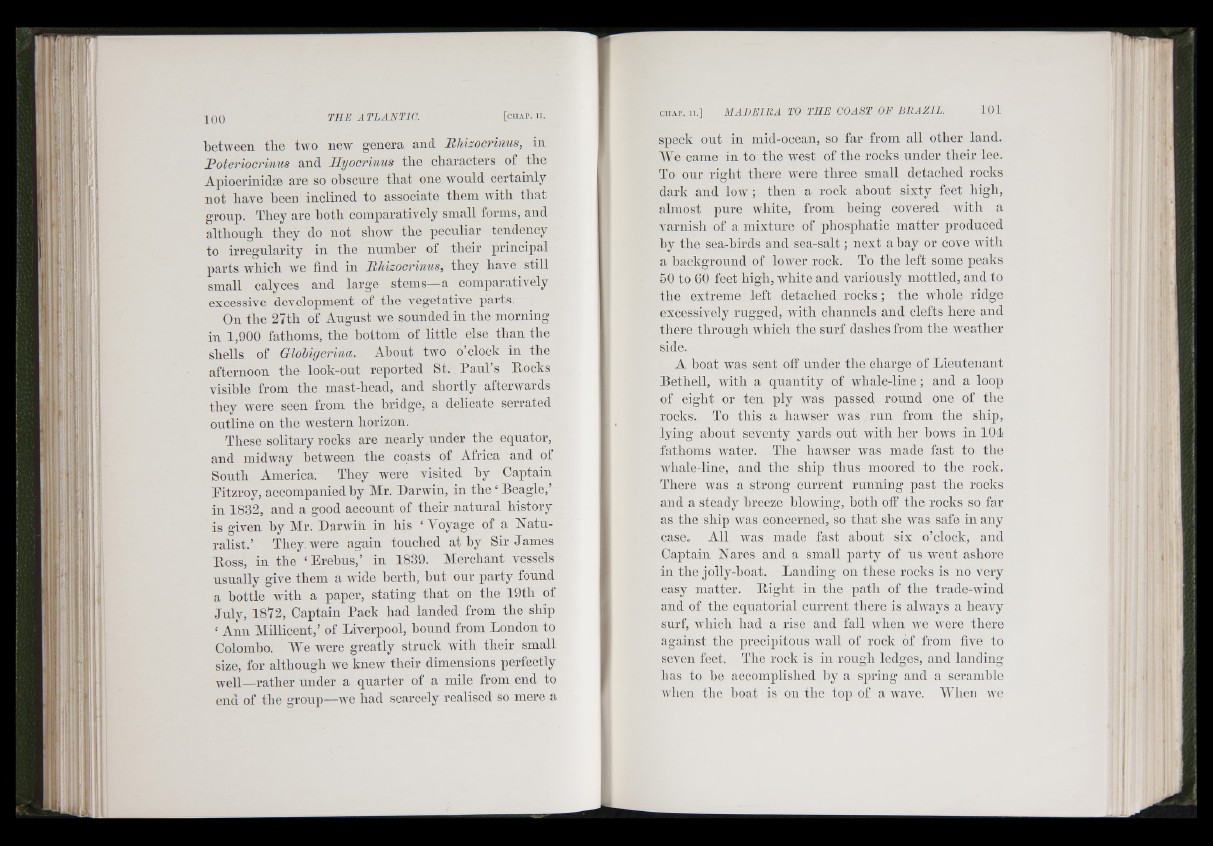
m , ri
I f : II
THE ATLANTIC. [c h a p . it .
between tlie two new genera and BhizociHnus, in
Poterioadmis and Hyocrimis tbe cbaracters of tbe
ApiocrinidcB are so obscure tliat one AA'onld certainly
not have been inclined to associate them with that
group. They are both comparatively small forms, and
although they do not show the peculiar tendency
to irregularity in the nnmher of their principal
parts which we find in BhizoGrinus, they have still
small calyces and large stems—a comparatively
excessive development of the A^egetatXe parts.
On the 27th of August avc sounded in the morning
in 1,900 fathoms, the bottom of little else than the
shells of Glohigerina. Ahont two o’clock in the
afternoon the look-out reported St. Paul’s Pocks
visible from the mast-head, and shortly afterwards
they were seen from the bridge, a delicate serrated
outline on the western horizon.
These solitary rocks are nearly under the equator,
and midway between the coasts of Africa and of
South America. They were visited hy Captain
Titzroy, accompanied hy Mr. Darwin, in the ‘ Beagle,’
in 1832, and a good account of their n a tu ral history
is given hy Mr. DarAA'ih in his ‘ l oyage of a N a tu ralist.’
They, were again touched at by Sir James
Boss, in the ‘Erebus,’ in 1839. Merchant vessels
usually giAY them a Avide berth, hnt our party found
a bottle Avith a paper, stating th a t on the 19th of
July, 1872, Captain Pack had landed from the ship
‘ Ann Millicent,’ of Liverpool, hound from London to
Colombo. M^e Avere greatly struck Avith their small
size, for although Ave knew their dimensions perfectly
Avell—rather under a quarter of a mile from end to
end of the group—Ave had scarcely realised so mere a
m
speck out in mid-ocean, so far from all other land.
We came in to the Avest of the rocks under their lee.
To our rio-ht there were three O small detached rocks
dark and loAV ; then a rock about sixty feet high,
almost pure AA'hite, from being covered Avith a
varnish of a mixture of phospliatic matter produced
by the sea-birds and sea-salt; next a bay or cove Avitb
a background of lower rock. To the left some peaks
60 to 60 feet liigb, Avliite and variously mottled, and to
the extreme left detached rocks ; the aaJioIc ridge
excessively rugged, Avith channels and clefts here and
there tbrousOrb Avbich tbe surf dashes from tlie Aveatlier
side,
A boat Avas sent off under the charge of Lieutenant
Bethell, Avith a quantity of wbale-line; and a loop
of eight or ten ply Avas passed round one of the
rocks. To this a haAvser Avas ru n from the ship,
lying about seventy yards ont with her hoAA's in 104
fathoms Avater. The hawser Avas made fast to the
AA'hale-line, and the ship thus moored to the rock.
There was a strong current running past the rocks
and a steady breeze hloAA'ing, both off the rocks so far
as the ship Avas concerned, so th a t she Avas safe in any
case. All Avas made fast about six o’clock, and
Captain Nares and a small party of us Avent ashore
in the jolly-boat. Landing on these rocks is no very
easy matter. P ig h t in the path of the trade-Avind
and of the equatorial current there is ahvays a heavy
surf, AA'liich had a rise aud fall Avlien Ave Avere there
against the precipitous Avail of rock of from fiA'e to
seven feet. The rock is in rough ledges, and landing
has to he accomplished hy a spring and a scramble
Avhen tbe boat is on tlie top of a Avave. lYlien Ave
i ! ' <